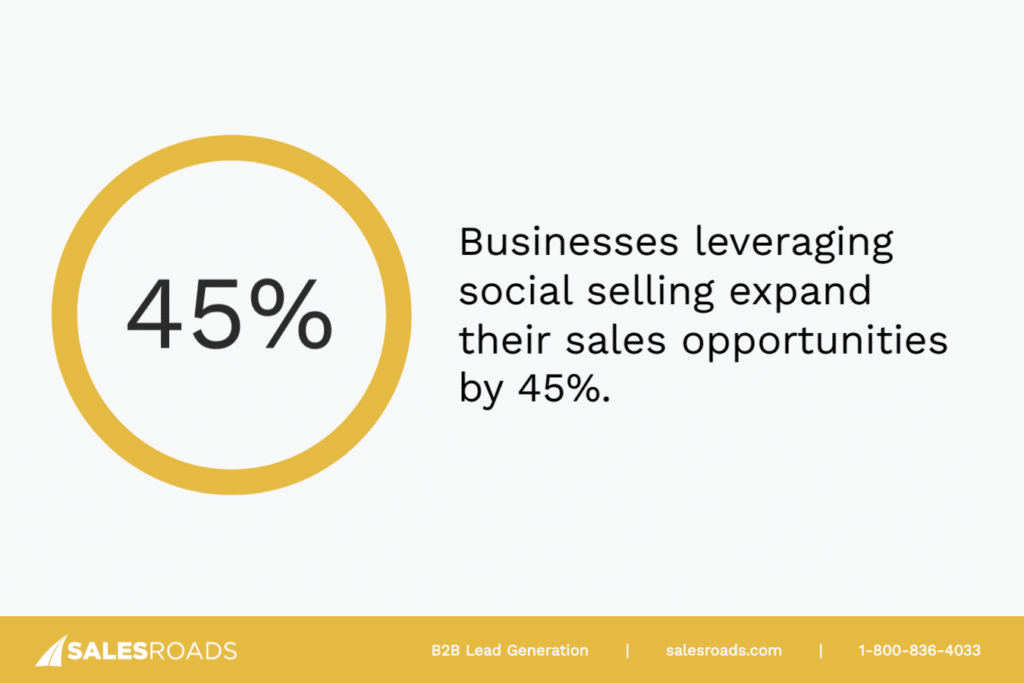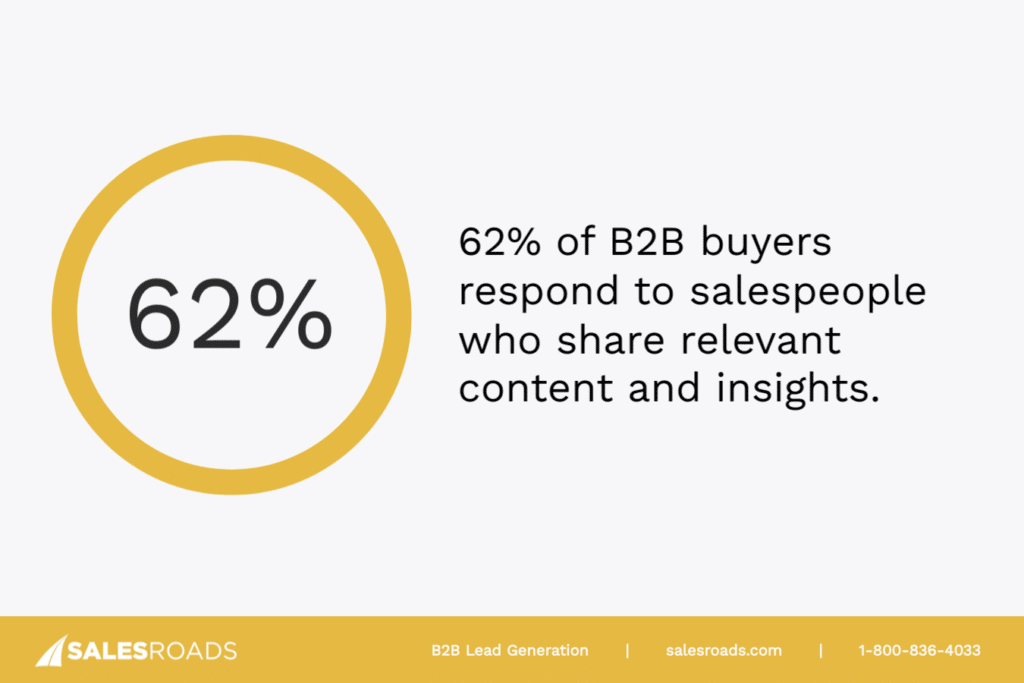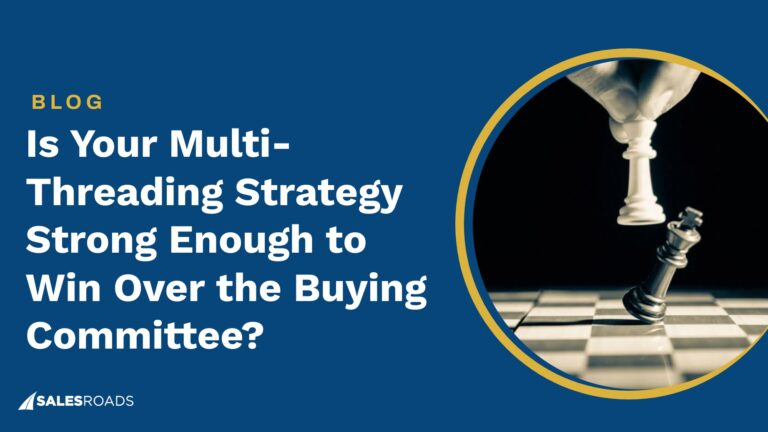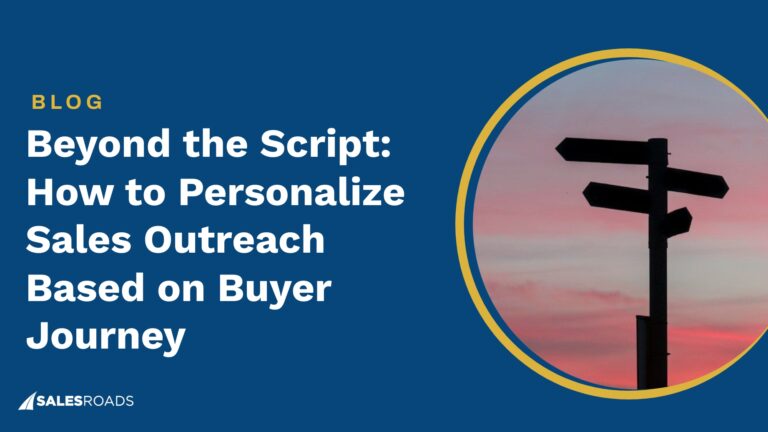The digital age has forced the art of selling to evolve and prompted salespeople to embrace new techniques to improve their effectiveness. Sales professionals are discovering the value of augmenting traditional methods with newer approaches.
One such method is social selling, an increasingly popular tactic. It involves leveraging social media platforms and digital channels to build meaningful relationships with potential customers.
Social selling doesn’t diminish the importance of traditional approaches though; rather, it enhances them by focusing on engaging, educating, and nurturing connections that align with the buyer’s journey.
Why Include Social Selling in Your Outbound Sales Strategy
A LinkedIn-sponsored white paper found that “75% of B2B buyers and 84% of C-level/vice president (VP) executives surveyed use social media to make purchasing decisions.” To stay ahead of the curve, sales professionals seek fresh strategies to foster connections, deliver value, and drive meaningful conversations with prospects — and social selling has come to answer the challenge.
Changing Sales Landscape
The days when the majority of sales occurred within brick-and-mortar stores are gone. Technological advancements and digital convenience have triggered a seismic shift in customer behaviors.
Potential customers now traverse multiple paths across the digital sphere before buying, and those touch points open a wealth of opportunities for you to reach out and nurture your brand’s relationship with them. They expect more than generic emails and messaging; they respond best to personalized, value-driven outreach and view the cookie-cutter approach of times past unfavorably.
Social selling emphasizes personalization and relationship-building. That combination allows salespeople to meet prospects where they are, engage in authentic conversations, and flourish in the competitive and evolving realm of sales.
The ROI of Social Selling
Although some see social selling as just a trendy buzzword, it’s proven to deliver tangible results. It’s a powerful asset to build deeper relationships with prospects, facilitate trust, and produce an impressive ROI.
A study conducted by Aberdeen, for instance, revealed that 64% of teams that employed social selling hit their quota, compared to 49% of teams that didn’t.

Also, findings from Hootsuite suggest businesses that leverage social selling in their marketing strategies expand their sales opportunities by 45%.
Investing in social selling can thus significantly help you move prospects through your sales funnel quickly and secure more sales.
Best Social Selling Platforms for Sales
The social selling platform you choose can make the difference between barely hitting your quote and exceeding your sales goals.
The right platform depends on your industry, target audience, and the relationships you aim to nurture. Consider the following options to kick-start your search.
On LinkedIn, salespeople gain access to a business-focused network of over 950 million users.
This professional playground offers the chance to reach decision-makers directly and build rapport with them.
X (formerly Twitter)
X can be a valuable platform to monitor trends, create engagement, and develop a robust online presence. Key influencers, industry experts, and decision-makers congregate here to share opinions and thoughts on the latest industry happenings.
Other Platforms
Facebook, which boasts 3 billion users, maintains a blend of personal and professional networks so you can target a variety of market segments. Meanwhile, Instagram and Pinterest offer high visual impact, perfect for selling visually appealing or uniquely designed products within the B2C landscape.
Niche platforms like Clubhouse or Medium may present unique opportunities depending on the industry. Success revolves around carefully selecting platforms that align with your selling needs and the demands of your target audience.
Social Selling Best Practices
The effectiveness of your social selling approach requires strategic implementation. Well-planned and carefully executed strategies yield tangible results.
Here are some actionable best practices to bolster your social selling game:
1. Optimize Your Social Profiles With a Professional Look
Your social media profile acts as your digital business card — it’s the initial point of contact between you and potential customers.
Prospects researching business solutions may encounter your social profile, so an engaging, professional-looking profile is essential to provide a compelling introduction.
Take time to refine your profile picture, banner image, title, summary, and even your posts and shares and produce a memorable first impression.
Use a clear and professional picture. The banner image, meanwhile, subtly hints at your service or product, so choose one that summarizes your offering and entices viewers to learn more.
Highlight your expertise, the value you offer, and your personal touch in your title and summary. The goal is to forge relationships, not broadcast sales pitches.
2. Set Goals and KPIs to Monitor
Do you aim to attract new leads, nurture existing ones, or build brand awareness? Establishing concrete goals creates clarity, narrows your focus, and aligns your efforts.
Meanwhile, KPIs function as your measurable outcomes and progress benchmarks. The social selling KPIs commonly include inbound connections and network growth, content engagement rate, prospect referrals, number of conversations started, and message response rate.
For instance, an uptick in engagement with morning posts indicates your audience is active at that time of day. Or, increased video engagement might correlate to higher response rates. You can use this data to fine-tune your approach and push more impressive results.
3. Craft a Networking Strategy to Build Relationships
Social selling emphasizes building relationships rather than pushing sales pitches. So, take steps to cultivate relationships with your prospects and grow your network, giving you a larger pool of leads to pursue.
Boolean Research
Find your prospects by thinking like a detective, using Boolean research as your magnifying glass.
Search operators like “AND,” “OR,” and “NOT” aid in narrowing down your target audiences on platforms like LinkedIn.
If you sell recruiting software and hope to connect with HR managers in the medical industry, use a search string like, “HR manager” AND “medical industry.”
Connecting With Your ICP
Your ICP (ideal customer profile) represents your most desirable potential customer.
To identify your ICP, commence by singling out your most valuable corporate clients and analyzing any common traits they possess. Delve deeper into factors like their industry sector, company size, and location, as well as their procurement patterns. Take note of the solutions or services they predominantly opt for, the challenges they frequently encounter, and the B2B strategies they engage with most.
The ICP of a B2B company offering supply chain optimization software might look like this:
“Our ideal customer is a manufacturing firm with 3-5 production facilities, located in the US, focusing on electronics and gadgets, with an emphasis on sustainable practices and an annual spending of $5 million or more on supply chain optimization and software solutions.”
Create a connection list named “top 100” that you included decision-makers within your ICP and start networking every single day.
Understanding your ICP aids in tailoring your outreach to the needs and interests of your audience. In turn, personalized connections boast superior acceptance rates.
Regular Engagement & Follow-ups
In social selling, persistence is key. Regular, meaningful follow-ups serve as gentle reminders of your presence, keeping you at the top of their minds.
Engaging with your connections—liking, commenting on posts, or sharing relevant content—can increase your visibility and solidify your relationships.
Pro Tip: Take advantage of profile views. This feature provides a list of professionals who viewed your profile page and offers a prime chance to turn curious visitors into viable prospects. On the flip side, when you view your prospects’ profiles, LinkedIn sends them a notification, ensuring you remain front and center.
4. Create Quality Content and Be Consistent
Content is king in social selling.
Craft quality, valuable content to position yourself as a thought leader in your industry. That can take the form of industry news, actionable tips, or your perspectives on trends. Whatever you share, make sure your content is relevant to your audience.

A LinkedIn report revealed that “62% of B2B customers respond to salespeople who connect by sharing content and insights that are relevant to the buyer.” So, engaging your target segment with consistent, well-crafted content fosters trust and nurtures the relationships you’ve built.
Social Selling Strategies for Salespeople to Utilize
Having learned social selling best practices, we’ve provided a few proven strategies that can catapult your sales endeavors.
Prospect on Multiple Platforms
Social media platforms are a unique resource for connecting with potential customers; however, rather than limiting yourself to one, harness the power of multiple platforms.
You can complement LinkedIn networking with Twitter conversations, or take advantage of Facebook’s rich personal profiles. For instance, a tech consultant might find startup CEOs to target on LinkedIn while discovering content marketing trends on Twitter.
Focus on Personalized Outreach
No two potential customers are identical, so your communications with them should reflect that uniqueness.
To personalize your outreach, gather insights from your prospect’s profile. This helps your connection request or DM stand out from countless generic messages.
One strategy to differentiate yourself from the crowd is with a tailored video message or voicemail.
Assume you’re contacting a potential sales training client; a concise video demonstrating a training activity concept is more likely to outperform a text-based explanation.
Engage in Virtual Meetings, Webinars, and Events
Actively participating in (or even hosting) webinars and virtual events provides an opportunity to showcase your expertise, initiate meaningful conversations, and solidify your relationships.
Integrate Social Selling Into Your Sales Funnel
Social selling isn’t a separate entity; it should integrate into your sales funnel. You can nurture early-stage leads through informational posts and insightful discussions. The demo offers and case studies, meanwhile, can nudge a mid-funnel lead closer to conversion.
Social Selling Pitfalls and How to Avoid Them
Even with the best strategies and practices, certain obstacles can hamper your social selling efforts. Knowing these traps can help you avoid them.
Over-Selling and Spamming
As previously stated, social selling emphasizes building relationships, not making a hard sell.
Constant sales pitches or incessant promotion of your product can quickly alienate prospects and hurt their likelihood of engaging with you. Imagine a prospect’s inbox overcrowded with messages from other salespeople. Your message, saturated with sales pitches, will blend into the crowd.
Effective communication with your prospects requires more than pushing your product’s features. A personalized message that acknowledges a prospect’s recent achievement or offers insightful content will stand out and stay top of mind when they’re ready to make a purchase.
Keep your approach friendly, genuine, and personal. Social selling is about playing the long game; its success hinges on the cultivation of trust and relationships, rather than making rapid-fire pitches.
Lacking a Strategy in Your Social Selling Efforts
Although informal in nature, social selling demands a strategic approach. Without explicit goals or a clear understanding of your ICP, you’ll waste your time and resources.
Direction provides a straightforward path. Setting goals, knowing your ICP, and mapping your strategy will guide your efforts toward more fruitful results. It’s equally important to monitor your course and make adjustments as well. Your focus should remain fixed on building lasting, valuable relationships that are mutually beneficial.
Bottom Line
Leveraging social media platforms, sales professionals are given the tools to establish, nurture, and deepen relationships with potential customers to eventually seal the deal. A well-executed social selling strategy can significantly boost sales outcomes.
As B2B sales navigate this changing landscape, the emphasis is clear: seamlessly integrate authentic relationship-building social selling strategies without sidelining the invaluable traditional methods that have stood the test of time.










